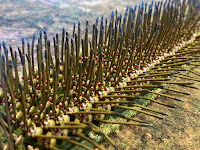Pynda - The Challenges.
- How to rebase my 6mm figures, which were based on the traditional DBA style, with 40mm x 20mm rectangular bases.
- Strength and Honour work well solo, but I wanted to strengthen the uncertainty. This problem is more acute for solo wargamers when they attempt to refight a historical encounter. Therefore, I produce several What-If changes to the standard battle layout.
Rebasing
I wanted to obtain the impression of very different mass formations moving across the battlefield, a distinct advantage of using the 2mm scale. To replicate this in 6mm, I used three basing options.
1. Phalanxes and Legions. I used the standard 120mm x 60mm bases for these formations. The photo below shows the mass phalanx formation, which creates the right impression. The Roman manipular legion proved a more complex subject. Initially, I covered it with a small block of figure offset to give the chequered board effect. However, this solution lost the impression of mass. Therefore, as suggested in the supplement, I opted for two ranks of miniatures with the triarii and velites mounted on separate bases. This is the version I adopted, but I am still looking for a better solution.Battle Set-Up.
- Ancient sources like Livy and Plutarch focus on the morality and tactics of the commanders (Perseus' cowardice, Roman adaptability).
- Modern scholars reframe the battle in terms of terrain, timing, and logistics, demonstrating how chance and topography created the opportunity for the Romans. Rather than a simple morality tale, modern reconstructions present Pydna as a chaotic, hastily joined battle in which small battlefield features had outsized impacts.
In the end, I opted for a dry river bed that crossed the battlefield, with the land gradually rising on the Roman side. As mentioned in the Strength & Honour supplement, the dry river bed did not play a significant role in the battle. More critical was the broken ground that disrupted the phalanx's advance. Most of this fractured ground was placed on the Roman side of the river, to reflect that the phalanxes only struggled with their formations once they had started to push the legion back.
What IFs
- Perseus was notoriously frugal with his treasury, and the sources suggest that he had the opportunity to recruit more Galician mercenaries; therefore, consider adding another warband or cavalry unit to the Macedonians.
- It is alleged that Perseus was ill, had poor command ability, or was a coward and played little part in the battle. To reflect this interpretation, the Macedonians cannot use the Command Board for 1d6 rounds. An alternative mechanism is that each round, the Macedonian side rolls 1d6; if the result is 1, the command board can not be used for that turn.
- The broken ground was more important than the legion's superiority over the phalanx. Remove 1d6 pieces of open ground to open up the battlefield. This option could also test Perseus's ability to remain on the defensive ground.
- The ancient sources emphasise Aemilius Paulus' augury skills and their impact on Roman morale. The add +2 to 'Consulting the Auguries.
- The battle was a meeting engagement, and the Macedonian phalanx had difficulty deploying its ranks. Remove the light infantry skirmish (it has already occurred), and the Romans gain a free first move; then the initiative is decided as normal.
- Macedonian cavalry is fartigued to simulate the friction between Perseus and his nobles.
Some Reading
Backhouse, M., (2024), Conquest, Alexander to Hannibal. A Supplement for Strength & Honour. Reisswitz Press.
Burton, P. J., (2017), Rome and the Third Macedonian War, Cambridge
Cole, M., (2018), Legion Versus Phalanx, Osprey
Head, D., ((1982), Armies of Macedonian and Punic Wars 359BC- 146BC, drawing by I, Heath, Wargames Research Group
Sabin, P., (2009), Lost Battles. Reconstructing the Great Clashes of the Ancient World, Continuum
Wrightson, G., The Third Macedonian War and the Battle of Pydna, Penn & Sword.








No comments:
Post a Comment